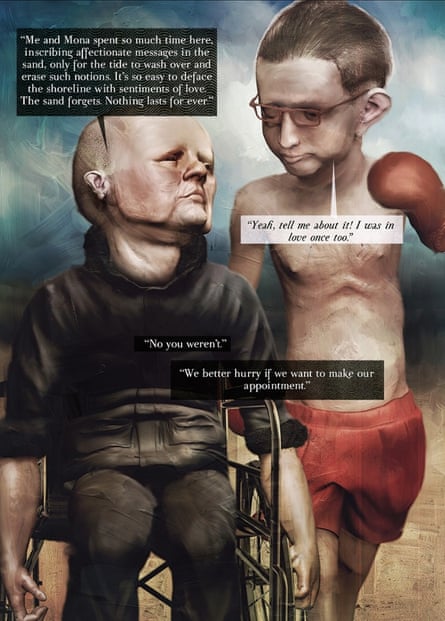Before we begin, two quick things. The first is that Lucia by Andy Hixon should really come with some kind of health warning, for it certainly isn’t for the faint-hearted. Yes, it’s sometimes blackly funny. But it’s also grim: you may find yourself falling into a dark mood on reading it. The second is that, try as I might to describe it to you, I’m almost bound to fail. I can’t remember the last time I saw artwork so disorienting or weird. I’ve no idea how Hixon does it – is a computer involved? – but his pictures are both deeply macabre and disturbingly realistic, like photojournalism gone badly wrong. Combine a particularly evil-minded Channel 4 documentary – let us call it Gutter Street – with Jonathan Glazer’s alien movie Under the Skin, throw in a few old episodes of The League of Gentlemen and… well, to be honest, you’re not even halfway there.

We are in a dystopian near future. Lucia is a seaside town that’s down on its luck: think Margate before the gentrifiers arrived with their cupcakes and mid-century furniture. Everything is closed, everyone is unemployed, and all the while the cliffs are falling into the sea. Our guides in this hell are Brick and Morty. The former is a fantasist shadow boxer too poor even to own any clothes, the latter a heartbroken disabled divorcee. Together, they take us to Lucia’s various “hives”: the Job Hive, which may bear a remarkable resemblance to your local Jobcentre Plus, save for the crucial difference that it can only be reached by rowing boat; the Money Hive, which is a pawn shop, and the Video Hive, where a small bag of ancient VHS tapes is yours for £5, and a large one for £10. Brick and Morty earn a living collecting scrap from along the side of the motorway. Their idea of a treat is a trip to Wendy’s Cafe, a filthy hole on whose “menu” there is only one dish that is safe to eat: chips with gravy (the “seafood” will kill you).
Nothing much happens in Hixon’s book. The characters banter a bit, and contort their wasted bodies, and hitch a ride on a diminutive seaside donkey called Don-K (nothing is quite the right size in Lucia). But plot isn’t really the point here. This is a grisly hallucination, not Book at Bedtime. Open Lucia, and you won’t be able to do anything but gawp, pop-eyed, at the grisly spectacle of its feral denizens: their pasty flesh, their twisted faces, their red eyes. Impossible to turn away. They are so pathetic, in both senses of the word: bruised and battered, and yet still so grimly chipper, so determined that something – anything – will turn up. Dickens would have recognised them and so, too, would JG Ballard. I suppose what I’m feeling my way towards saying is that, above all, Lucia reads like a warning. It is a book that rages furiously against neglect.
Lucia is published by Jonathan Cape (£16.99). Click here to order it for £13.59


Comments (…)
Sign in or create your Guardian account to join the discussion